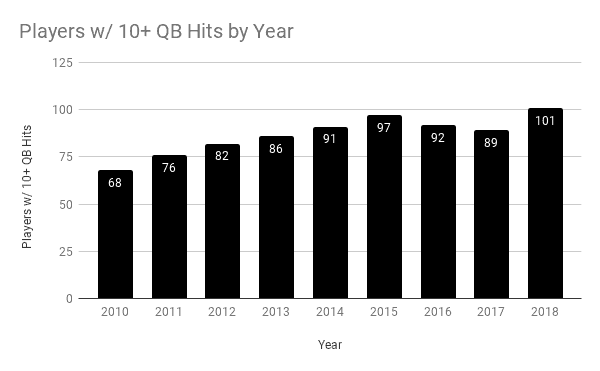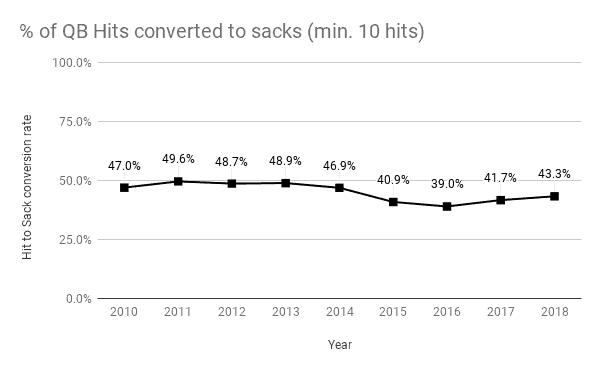The conversation about pass rushing has changed. It’s now more widely accepted that the act of creating pressure alone is enough to upset an opposing offense. There are also smarter conversations about the optimal ways to create pressure and which parts matter more. Still, when it comes to resources for the pass rush, sacks are where the money is made.
Sacks, though, aren’t always a constant from year-to-year. At a team level, pressure rate is better than current sack rate at predicting future sack rate. Here are the year-to-year correlations from 2015-2018, per data from Sports Info Solutions.

This is also true at the player level. Another good indicator of future performance is sacks per quarterback hit. Over the past few seasons, more players have gotten to the quarterback. 101 defensive players had at least 10 quarterback hits in 2019. Part of this comes from blitzing, part from more defensive rotations, and part from better bookkeeping on quarterback hits themselves.

source: pro-football-reference
But while more players are getting to the quarterback, the rate at which quarterbacks are being brought down is not increasing. There was a huge dip in conversion rate from 2014 to 2015 and that has only started to slightly rise back up in 2017 and 2018.

source: pro-football-reference
Some of this can be attributed to the emphasis on shorter and quicker passes by NFL offenses. In previous research I’ve done about sacks and time to throw, I found using the NFL’s Next Gen Stats data that there were 1,281 sacks across the NFL during the 2018 regular season. Three of those sacks (0.2 percent) occurred under 2.0 seconds, 29 (2.3 percent) happened under 2.5 seconds, and 113 (8.8 percent) were under 3.0 seconds. Meanwhile, thirty-two of 34 qualified quarterbacks had their average time to throw below 3.0 seconds in 2018. Modern offenses have made it harder to pick up sacks.
Still, the quarterback hits have risen and sacks per quarterback hit remain a solid starting point for predicting sack regression for the upcoming season. With that in mind, we’ll take a look a a few players who underperformed their expected sacks last season and could be in line for a bump in sack totals and a few on the other side.
Yannick Ngakoue, Jacksonville Jaguars
QB Hits: 33
Sacks: 9.5
Sacks/Hit rate: 28.8 percent
Ngakoue’s place on this list isn’t much of a surprise because of how dominant a pass rusher he has been since he entered the league in 2016. What makes his placement here interesting, though, is as a third-round pick, 2019 will be the final year on his rookie contract. With 29.5 career sacks over his first three seasons, Ngakoue is already due for a big payday on his second contract, but a massive 2019 could add a significant amount to that total.
Last season, Ngakoue’s 33 quarterback hits ranked third in the league and first among players who primarily played on the edge. Only Aaron Donald (41) and Fletcher Cox (34) hit the quarterback more often. By using the standard conversion rate over the past nine seasons, we could have expected Ngakoue to have nearly 14 sacks with that many hits. Instead, he had just 9.5 — the biggest gap between actual and expected sacks in the league last season. Converting on just 40 percent of his hits would have given Ngakoue 13 sacks on the season. Expect his sack totals to increase in 2019 and a hefty payday to follow.
Za’Darius Smith, Green Bay Packers
QB Hits: 25
Sacks: 8.5
Sacks/Hit rate: 34 percent
Smith is an interesting case here because he already got paid. Smith spent the past four seasons as a rotational pass rusher for the Baltimore Ravens and maxed out playing 66.7 percent of the defensive snaps last season. But Smith was a constant presence in the backfield and because good pass rush doesn’t hit the open market often, the Packers offered Smith a four-year/$66 million contract with $20 million guaranteed.
Despite his 8.5-sack season in 2018, Smith played as a much better pass rusher than that. His 25 quarterback hits tied with J.J. Watt for 10th-most among defenders and would be expected to come to about 10.7 sacks. Now as one of his team’s top pass rushers — Green Bay also signed Preston Smith, who also underperformed his sack expectation (four sacks on 16 hits) — Smith could look like a smart investment with a higher sack total in 2019.
Arden Key, Oakland Raiders
QB Hits: 11
Sacks: 1
Sacks/Hit rate: 9 percent
The Oakland Raiders objectively had the worst pass rush in the league last season. That’s probably going to be the case when a team trades a star like Khalil Mack before the season. Oakland finished with the worst pressure rate and worst sack rate in the league. They tried to fix that in that draft with first-round pick Clelin Ferrell from Clemson and fourth-round pick Maxx Crosby from Eastern Michigan. But one of the biggest improvements could come from within, specifically Adren Key. Key, a third-round pick in 2018, had a rough pre-draft process that raised questions about off-field behavior and his workouts (specifically in that link by current Raiders general manager Mike Mayock). By sack totals, Key’s one-sack rookie season would also look like a disappointment, but he was mostly unlucky when finishing. He had 11 quarterback hits, which would expect to result in about five sacks. He also did this with little help anywhere else on the defense. Regression — just nine percent of his hits turned into sacks — and more pass rush help around him could help Key finish more sacks and look like the pass rusher many envisioned while he was at LSU.
Kyler Fackrell, Green Bay Packers
QB Hits: 12
Sacks: 10.5
Sacks/Hit rate: 87.5 percent
No player with at least 10 quarterback hits converted a higher rate into sacks. Fackrell’s 87.5 percent conversion rate is unreal and unlikely to translate into 2019. Fackrell got a boost in playing time in 2018 — a jump from 42.5 percent of defensive snaps played in 2017 to 58.6 percent last season. He wasn’t in the backfield much more often in 2018 with a slight increase of quarterback hits from seven to 12, but his sacks increased from three to 10.5. We would expect about 5.5 sacks from a player with 12 quarterback hits in a season. Fackrell’s sack total was already likely to take a step back, but that could especially be the case with the additions of Za’Darius Smith, Preston Smith, and even first-round pick Rashan Gary.
Danielle Hunter, Minnesota Vikings
QB Hits: 19
Sacks: 14.5
Sacks/Hit rate: 76.3 percent
There are exceptions to every rule and Hunter could be one here. Over his four year career, Hunter has six sacks on nine hits (66.7 percent), 12.5 sacks on 19 hits (65.8 percent), seven sacks on 11 hits (63.6 percent), and 14.5 sacks on 19 hits (76.3 percent). Washington’s Ryan Kerrigan is a similar player who always tends to finish better than expected by this metric.
Still, even as Hunter is one of the best young pass rushers in the league, his 2018 conversion rate is unlikely to be sustained for 2019. This also isn’t to suggest Hunter is on the verge of becoming an average pass rusher. What’s more likely here is Hunter improves as a disruptive pass rusher and increases his quarterback hits but his sack total stays similar to what it was in 2018.
Chandler Jones, Arizona Cardinals
QB Hits: 18
Sacks: 13
Sacks/Hit rate: 72.2 percent
In 2017, Chandler Jones was a legitimate Defensive Player of the Year candidate — or least as legitimate as someone not named Aaron Donald could be. He led the league with 33 quarterback hits and 17 sacks. Those numbers were expected to drop off in 2018, but one fell off much more than the other. Jones totaled only 18 quarterback hits in 2018, which tied for 32nd among defenders, but his 13 sacks tied for seventh.
Arizona also was in the midst of a massive scheme change from James Bettcher’s aggressive 3-4 to Steve Wilks’s 4-3. The change was bumpy all the way around and Jones’s ability as a pass rusher was hampered in the process. This year the hope will be that new defensive coordinator Vance Joseph can get back to what the Cardinals’ defense looked like before the 2018 season. Still, for Jones to keep up his sack production, he’ll have to get to the quarterback way more often than he did last year.
















